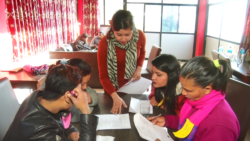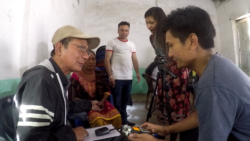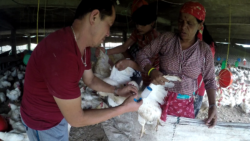CE4AMR: One Health Approach, our learnings so far...
The CE4AMR: One Health Approach is a network project supported by GCRF Challenge Cluster funding. Our aim is to exchange and synthesize knowledge from six existing projects to better understand how Community Engagement can support antimicrobial resistance (AMR) interventions in a variety of contexts across LMICs.
Our constituent projects began working together in June 2020, when our first task was to design a set of research questions to guide our knowledge exchange. We held online discussions about how best to capture our knowledge, whilst also leaving space to explore areas where we may not yet have expertise. Each project reflected on these conversations and fed-back, allowing us to refine six research questions (RQs). All project teams answered these questions separately, and an online meeting in September 2020 allowed us to share answers. From this we have consolidated our position on ways CE is currently being used to support AMR interventions in LMICs.
In this blog we share a macro-level summary of these answers, focusing on four key areas of learning.
- Towards a shared understanding of ‘community’.
- The context in which Community Engagement (CE) approaches are currently being utilized to tackle AMR.
- The barriers and challenges to applying CE methods to AMR research.
- The gaps in AMR research which could benefit from CE interventions.
Toward a shard understanding of community.
The CE4AMR: One Health Approach is keen to stress that no single definition of community will ever be equitable, representative, or applicable across the board. Who a community includes or excludes will depend upon a myriad of contextual factors, including but not limited to gender and intersectionality, geographical parameters, socioeconomic standing, education, and shared lived experiences including language, cultures, beliefs and practice.
Our work to date stresses that communities are not homogenous, and that people can belong to multiple communities simultaneously. This means defining a community based on narrow parameters will likely be exclusive. The factors used to define a community need to be understood in detail, collaborating with local stakeholders in an iterative way.  Our findings also highlight the difference between community and wider stakeholders. It is clear that projects should ask if these terms are interchangeable in their context, and if not, what does the differentiation between them mean? The ‘take-home messages’ from our work so far is that in all settings, communities should be allowed to define for themselves how they want to be understood and should be engaged in all aspects of project development as early as possible.
Our findings also highlight the difference between community and wider stakeholders. It is clear that projects should ask if these terms are interchangeable in their context, and if not, what does the differentiation between them mean? The ‘take-home messages’ from our work so far is that in all settings, communities should be allowed to define for themselves how they want to be understood and should be engaged in all aspects of project development as early as possible.
The context in which Community Engagement Approaches are currently being utilized to tackle Antimicrobial Resistance (AMR).
CE approaches are predominantly utilized to tackle the demand side of AMR. For example, projects frequently focus on understanding how people source antibiotic medications, and how they (mis)use them. As such, CE is mainly used within the context of human health, although a growing number of projects are considering similar questions with regard to the demand for agricultural antimicrobials used in food-producing animals.
The way communities are engaged with the issue of AMR is hugely variable. For example, communities may be asked to complete surveys on health practices, provide biological samples for analysis, be invited to discuss antibiotics in community groups, or be encouraged to explore their relationship with AMR through a variety of arts practices. These approaches are highly diverse and reflect a strong interdisciplinary interest in the use of CE to tackle AMR. However, projects do not always allow two-way knowledge exchange between the community and the research team.
All the projects involved in our network agree that effective CE strategies should employ mixed-method approaches. These combine quantitative data, for example around levels of infection, with qualitative insights into community practice/behavior such as cleaning or antibiotic usage. Community engagement is a process which allows two-way knowledge exchange, and this is particularly important when one is seeking to address AMR. ‘Experts’, for example, in the biology of AMR are currently struggling to understand the scale of the problem.  Academics, policy makers and health care workers have a lot to gain from listening to communities on topics such as drug access, usage, and disposal. That said, it is important that CE does not become an extractive process. Information must be fed back to the community in a meaningful way to allow them to make decisions on their own AMR-related behaviours, informed by information that they have ultimately generated themselves. CE can be particularly impactful here because it creates space for the community voice to be heard, for example through community-produced outputs. However as discussed below, this can also present challenges…
Academics, policy makers and health care workers have a lot to gain from listening to communities on topics such as drug access, usage, and disposal. That said, it is important that CE does not become an extractive process. Information must be fed back to the community in a meaningful way to allow them to make decisions on their own AMR-related behaviours, informed by information that they have ultimately generated themselves. CE can be particularly impactful here because it creates space for the community voice to be heard, for example through community-produced outputs. However as discussed below, this can also present challenges…
The barriers and challenges in applying the CE method to AMR research.
Community Engagement research hinges on the ability to create equitable partnerships. Whilst the community is best placed to understand their lived experience of a particular AMR problem, the biology of this issue often needs to be considered by a technical expert. This can create tension within CE projects, when a community-generated solution may need to be adapted to ensure good science is being communicated. Ensuring all stakeholders are connected from the start of the project, and explaining that review stages are an intended part of project development, can make this process more equitable.
Evaluating CE for AMR projects is tricky, especially if behavior change is an intended outcome. This is because both AMR and behaviour are dynamic, and influenced by contextual, environmental, economic and other factors. This makes it difficult to attribute any changes in behavior or level of AMR to a single CE intervention. There is also a lack of methodological guidance on how to evaluate CE in general. Our Co-investigators suggest that we could improve this by expanding our culture of sharing failures. Consolidating evaluative language is also particularly important because we lack a clear consensus on what we mean, and how we measure, the ideas of “success” and “failure” in CE.  This perhaps represents a challenge with regard to the interdisciplinary interest in AMR. With so many strategies being used to understand this problem we need to ensure results and impacts can be effectively communicated to multiple disciplines and stakeholders, including the community.
This perhaps represents a challenge with regard to the interdisciplinary interest in AMR. With so many strategies being used to understand this problem we need to ensure results and impacts can be effectively communicated to multiple disciplines and stakeholders, including the community.
Gaps in AMR research which could benefit from CE interventions.
This is an ongoing area of exploration for the CE4AMR: One Health Approach, and it will be contextualised following the National Stakeholder Workshops which are currently being delivered in Ghana Nepal, Bangladesh, India and Vietnam. Our view, at present, is that CE methods are rarely utilized beyond the human health aspect of AMR.  Environmental health is particularly neglected by CE, and agricultural/animal health is often addressed in side-projects mainly aimed toward safeguarding human health outcomes. Other gaps include the supply side of AMR; in LMICs there may be limited antibiotics available meaning that even AMR-engaged communities could end up using an unsuitable drug. Equally the enforcement of National Action Plan (NAP) guidance and Antimicrobial Stewardship rules are generally not addressed by CE interventions. We have been struck by how much public compliance has either helped or hindered efforts to reduce the spread of COVID-19 and there seems a clear opportunity to engage some of these methods in AMR interventions. Finally, CE projects often leave little space to address why a person or community behaves in a way that exacerbates AMR. Instead, the focus is invariably on promoting safe behaviors as a way to minimize AMR, without looking at the reasons by inappropriate behaviors Funding and time constraints have a big impact on these decisions but understanding why AMR-negative behaviors occur could be key to understanding why certain CE interventions appear successful while others do not.
Environmental health is particularly neglected by CE, and agricultural/animal health is often addressed in side-projects mainly aimed toward safeguarding human health outcomes. Other gaps include the supply side of AMR; in LMICs there may be limited antibiotics available meaning that even AMR-engaged communities could end up using an unsuitable drug. Equally the enforcement of National Action Plan (NAP) guidance and Antimicrobial Stewardship rules are generally not addressed by CE interventions. We have been struck by how much public compliance has either helped or hindered efforts to reduce the spread of COVID-19 and there seems a clear opportunity to engage some of these methods in AMR interventions. Finally, CE projects often leave little space to address why a person or community behaves in a way that exacerbates AMR. Instead, the focus is invariably on promoting safe behaviors as a way to minimize AMR, without looking at the reasons by inappropriate behaviors Funding and time constraints have a big impact on these decisions but understanding why AMR-negative behaviors occur could be key to understanding why certain CE interventions appear successful while others do not.
What next?
Co-Is are currently utilizing our findings to date to support National Stakeholder Workshops which bring together a range of health, policy, and academic stakeholders with the aim of better understand National AMR challenges. Our synthesis material introduces Community Engagement as a research tool, allowing teams to consider the potential for CE-based approaches to support current and future AMR interventions in each setting. All workshops are COVID-safe, which means several have had to move online, while others are being spread across several sessions to reduce the number of people in attendance. Look out for summary blogs detailing these workshops in the coming weeks!
Photos provided with permission by HERD International and the ARK Foundation who are partners within the CE4AMR: One Health Approach challenge cluster.
